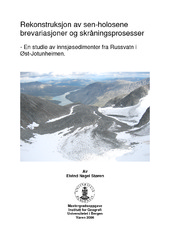| dc.description.abstract | This study considers an area located around the western part of lake Russvatn in eastern Jotunheimen, centralsouthern Norway. I have mapped processes in the catchment of this lake, and tried to connect these processes tothe sedimentation in the lake. To do this, a 293 cm long sediment core (BL1-05) was taken from the westernmostpart of lake Russvatn. The coring site is situated at a place where it is likely to get a signal from both glacial andnon-glacial processes that have been active throughout the Holocene.A multiproxy approach with signals from magnetic susceptibility, bulk density, loss on ignition andgrain-size distribution in the core has been used to analyse the BL1-05 core. I have done a brief evaluation of allthe methods used in the core analysis.There are nine episodic sedimentation events related to debris flows in the core. These events arerecognized mostly by their grain-size distribution, sorting and grading, and coupled with facies-models such asthe Bouma sequence. On the basis of mean grain-size, degree of sorting, and the amount of macrofossils, sevenflooding events are recognized in BL1-05. From these episodic events I have suggested a debris flowchronology, and thus an interpretation of extreme rainfall episodes in the area. The debris flow episodes wasmost frequent at 3850-4000 cal. yr BP, 2500-2600 cal. yr BP and around 1000 cal. yr BP. There were alsosmaller episodes at 685 and 520 cal. yr BP.The debris flow episodes seem to have a tendency to occur in periods with high ELA on the glacierBlackwellbreen. This could indicate the importance permafrost degradation in relation to these events.The properties of the sediments deposited at a more or less continuous rate throughout the Holocene arebelieved to reflect variations in the extent of the glacier Blackwellbreen. With the use of the analytic parametersmagnetic susceptibility, loss on ignition, bulk density, and coarse silt in these sediments, a late-Holocene glacierfluctuation-curve has been constructed. From this curve it is suggested that there was no glaciers in thecatchment in three periods at 3935-4037 cal. yr BP, 3630-3782 cal. yr BP, and 1878-2854 cal. yr BP. There washigher glacial activity than at present in the periods at 0-130 cal. yr BP, 450-575 cal. yr BP, 600-605 cal. yr BP,900-1050 cal. yr BP, 1080-1410 cal. yr BP, 1610-2200 cal. yr BP, 2530-2650 cal. yr BP, 2950-3070 cal. yr BP,3250-3670 cal. yr BP, and 3800-3930 cal. yr BP.In an attempt to determine the dominant thermal regime for each glacial period I have sketched amethod that with by use of grain size distribution in a proglacial lake can indicate the thermal regime of glaciersin the catchment. This method is at this point tentative, and has elements of uncertainty. However, to investigatethe potential of this method, it was used in a reconstruction of former glacier properties at Blackwellbreen. Onthe basis of this method it seems that periods at 3800-4000 cal. yr BP, 2850-3000 cal. yr BP, and also shortperiods around 630 cal yr BP and 100 cal. yr BP, have been dominated by a cold based thermal regime.This study demonstrates the importance of having a good understanding of the catchment, before doingany climatic interpretation based on lake sediments. | en_US |
